Tamil Nadu, a land of ancient temples, vibrant festivals, and deep-rooted traditions, is known for its diverse and expressive dance forms. The state has a rich artistic heritage, with dance playing an integral role in religious rituals, social gatherings, and cultural celebrations.
From classical Bharatanatyam to folk dances like Karagattam and Kummi, the dance forms of Tamil Nadu reflect the state’s history, devotion, and artistic excellence. These dances are performed during festivals, temple celebrations, marriages, and seasonal harvests, bringing communities together through music, movement, and storytelling.
Let’s explore the most famous traditional dance forms of Tamil Nadu, their origins, and their significance in Tamil culture.
1. Bharatanatyam – The Classical Dance of Tamil Nadu
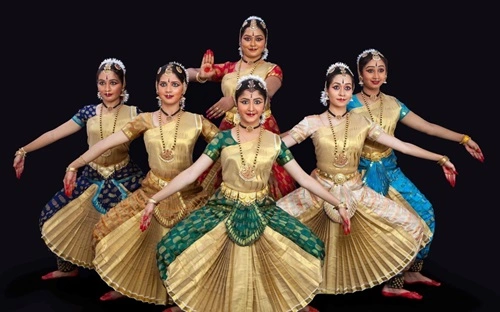
One of the oldest and most revered classical dance forms of India, Bharatanatyam originated in the temples of Tamil Nadu as a form of devotional dance. It was performed by Devadasis (women dedicated to temple service) as an offering to the deities.
- Features: Intricate footwork, graceful hand gestures (mudras), expressive facial expressions, and rhythmic movements.
- Themes: Hindu mythology, devotion to gods like Shiva, Vishnu, and Parvati.
- Occasions: Temple festivals, cultural events, and dance performances.
Bharatanatyam is deeply spiritual, combining Bhava (expression), Raga (melody), Tala (rhythm), and Natya (drama), making it a symbol of Tamil Nadu’s artistic and religious heritage.
2. Karagattam – The Pot Dance of Tamil Nadu
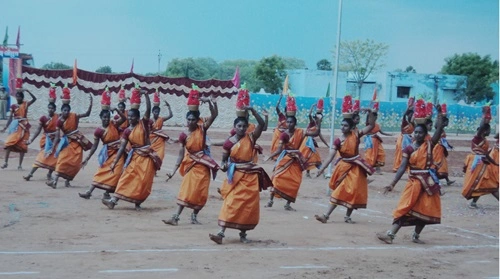
Karagattam is a folk dance performed in honor of the rain goddess Mariamman, where dancers balance a decorated pot (karagam) on their heads while performing graceful yet energetic movements.
- Features: Acrobatic stunts, rhythmic swaying, and balancing pots on the head.
- Themes: Worship of deities, gratitude for rain and prosperity.
- Occasions: Mariamman festivals, temple celebrations, and village fairs.
There are two types of Karagattam:
- Aatta Karagam – A devotional dance performed in temples.
- Sakthi Karagam – A dance performed for entertainment.
Karagattam is accompanied by traditional Tamil folk music, making it a joyful and visually captivating performance.
3. Kummi – The Traditional Women’s Dance
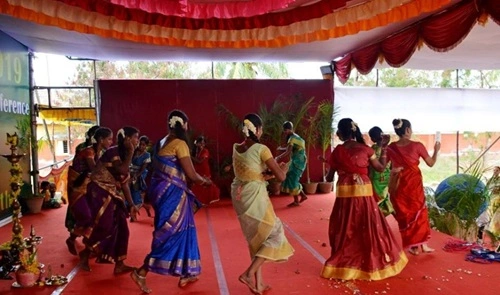
Kummi is a simple yet rhythmic folk dance, performed by women standing in a circle, clapping hands while singing traditional folk songs. It is one of Tamil Nadu’s oldest dance forms, commonly performed during harvest festivals and social gatherings.
- Features: Circular formations, rhythmic claps, and folk songs.
- Themes: Celebration of harvest, joy, and community bonding.
- Occasions: Pongal (harvest festival), Navaratri, and village fairs.
Kummi dance is a symbol of unity, bringing women together in a graceful and synchronized movement.
4. Mayilattam – The Peacock Dance
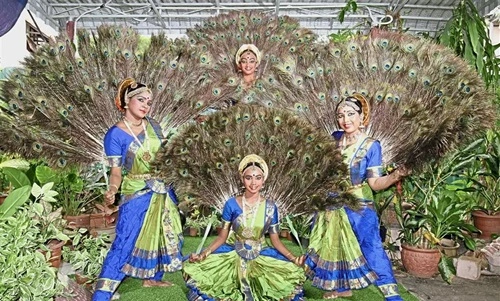
Mayilattam, or the Peacock Dance, is performed in temples and religious festivals, where female dancers dress as peacocks, with elaborate feathered costumes, mimicking the elegant movements of the bird.
- Features: Colorful costumes, intricate peacock-like movements, and devotional themes.
- Themes: Devotion to Lord Murugan (the peacock is his vahana).
- Occasions: Murugan temples, Thaipusam festival, and Navaratri.
Mayilattam is a visually stunning dance, symbolizing beauty, devotion, and divine grace.
5. Oyilattam – The Graceful Dance of Tamil Nadu
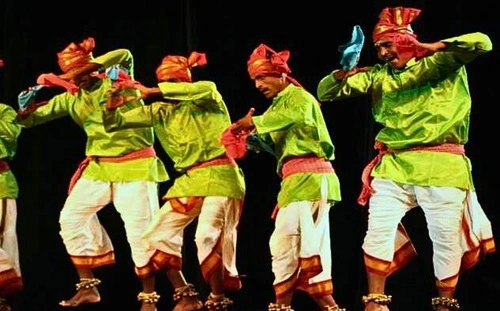
Oyilattam (meaning “graceful dance”) is a folk dance traditionally performed by men, featuring colorful flags, rhythmic steps, and synchronized group formations.
- Features: Vibrant costumes, graceful movements, and rhythmic footwork.
- Themes: Victory, heroism, and social storytelling.
- Occasions: Temple fairs, cultural events, and rural celebrations.
Oyilattam has gained popularity among both men and women, making it an important part of Tamil Nadu’s folk dance culture.
6. Kavadi Attam – The Devotional Dance of Lord Murugan
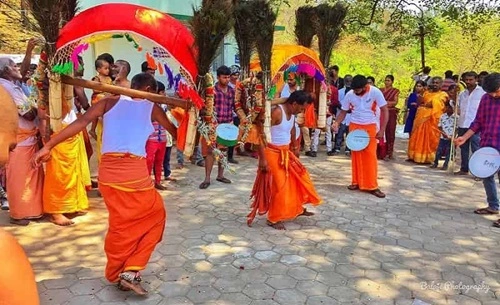
Kavadi Attam is a ritual dance performed by devotees of Lord Murugan, carrying a decorated wooden arch (Kavadi) on their shoulders as an act of penance and devotion.
- Features: Carrying the Kavadi, swaying movements, and chanting prayers.
- Themes: Devotion, surrender, and seeking blessings from Lord Murugan.
- Occasions: Thaipusam festival and temple processions.
Devotees walk barefoot for miles, performing this dance as part of their spiritual offering, making it one of Tamil Nadu’s most intense and sacred dances.
7. Therukoothu – The Street Theatre Dance
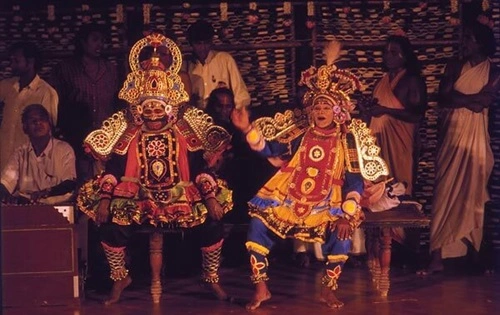
Therukoothu, meaning “street theatre,” is a folk dance-drama performed in open-air settings, blending dance, music, and storytelling. It is one of Tamil Nadu’s oldest folk arts, dating back centuries.
- Features: Exaggerated facial expressions, dramatic storytelling, colorful costumes.
- Themes: Hindu epics, social issues, and historical legends.
- Occasions: Temple festivals, village fairs, and special occasions.
Therukoothu performances are entirely improvised, with actors using song, dialogue, and dance to captivate their audience.
8. Poikkal Kuthirai – The Dummy Horse Dance
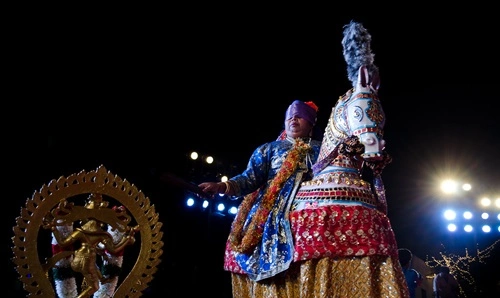
Poikkal Kuthirai, meaning “False-Legged Horse Dance,” is a folk dance where performers wear a wooden horse frame around their waist, creating the illusion of riding a horse while dancing.
- Features: Horse-like movements, fast-paced steps, and dramatic storytelling.
- Themes: Heroic tales, village folklore, and mythology.
- Occasions: Temple festivals, village fairs, and special celebrations.
This dance is performed with energetic beats and vibrant costumes, making it a fun and theatrical experience.
9. Devarattam – The Dance of the Tamil Kings
Devarattam, meaning “Dance of the Gods,” was historically performed by Tamil kings and warriors to celebrate victories. It is a martial art-based dance performed with graceful movements and rhythmic beats.
- Features: Energetic footwork, traditional drum beats, and warrior-like formations.
- Themes: Bravery, heroism, and Tamil pride.
- Occasions: Victory celebrations, temple festivals, and folk gatherings.
Today, Devarattam is performed at cultural festivals, keeping Tamil Nadu’s royal dance traditions alive.
Conclusion
Tamil Nadu’s traditional dances are a blend of devotion, folklore, and artistic expression, reflecting its rich history and cultural vibrancy. From the classical elegance of Bharatanatyam to the playful energy of Karagattam, and the theatrical storytelling of Therukoothu, each dance form carries a unique identity and deep-rooted significance.
These dance traditions continue to thrive, celebrated at temples, festivals, and cultural events, ensuring that Tamil Nadu’s artistic legacy remains alive for future generations. Whether performed in local villages or international stages, Tamil Nadu’s traditional dances captivate audiences, preserving the state’s cultural heritage and artistic brilliance.

